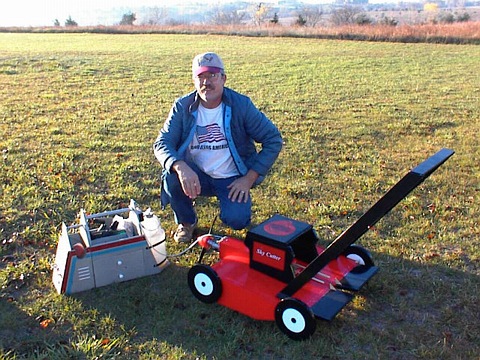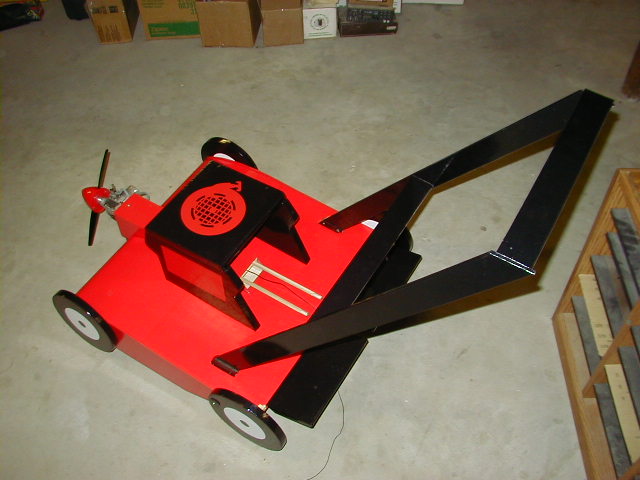
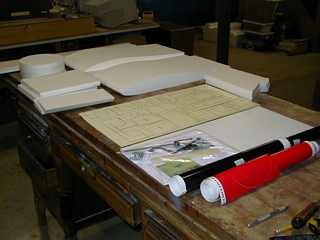
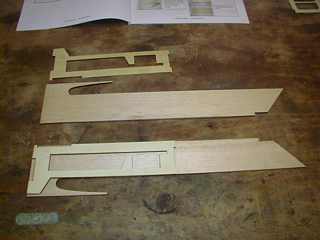
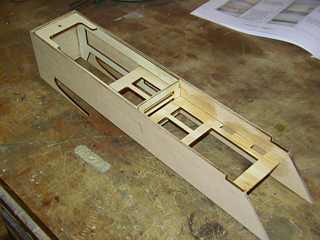

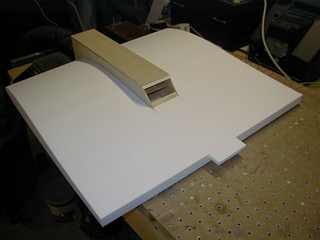
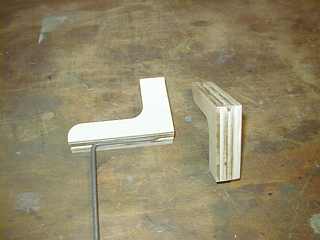
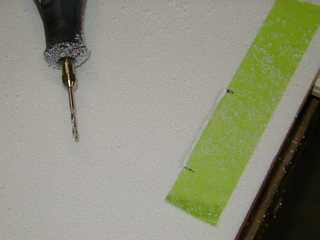
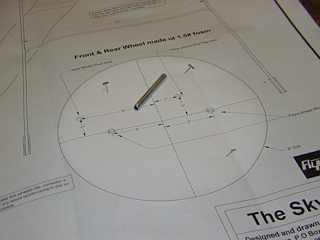
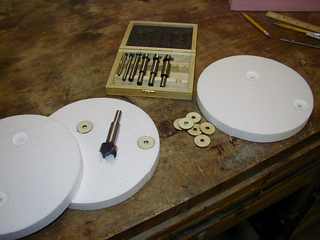
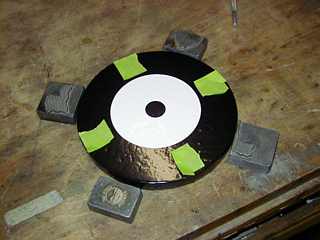
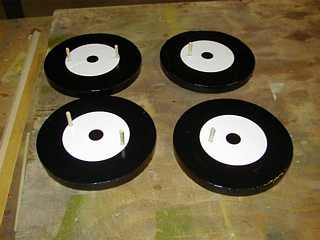
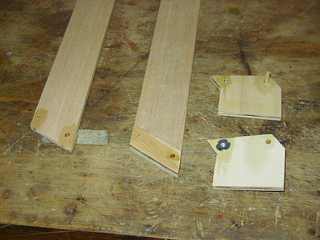
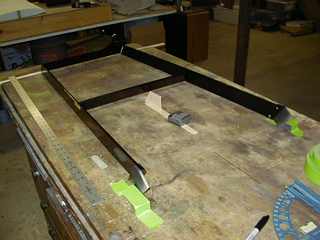
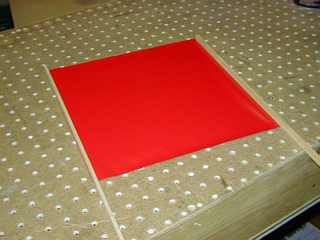
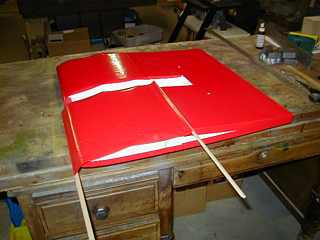
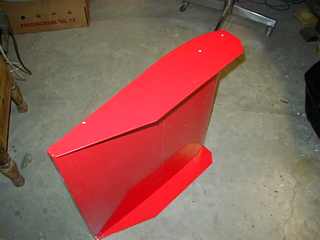

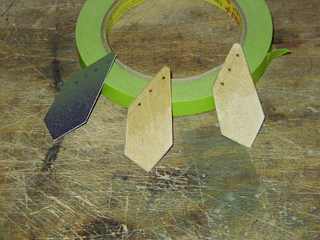
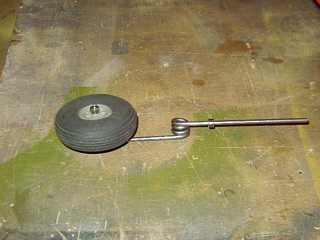

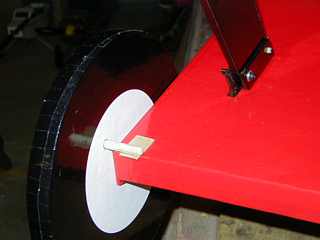
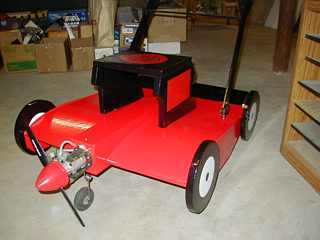
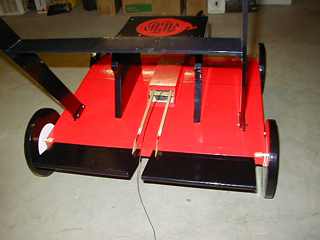
Construction Highlites of the Flying Thingz funfly Lawnmower
This page is provided to help other prospective builders of this kit. I've made a few changes from what the plans and or booklet calls for. Changes will be explained with my reasoning for the change, be it good or bad at completion of the project.
Overall, and if built completely via the instructions I think this is one huge value in r/c modeling. Levi, of Flying Thingz has done a tremendous job of bringing this fun kit to us. His support while I was building mine was invaluable. Thank you Levi, and thanks for a real fun project...all my best to you.... Randy Linderman
And on with the fun!
The kit, out of the box for inspection. I also ordered the red and black covering option. Make certian to order the covering with the kit.. I couldn't imagine building it without the peel and stick covering now that I have used it. It is the only way to go!
Fuse doublers being glued to the balsa sides. Be sure to lay them out as shown so you will have a left and a right side when finished.
Lower the servo trays as much as possible or you will have a hard time with servo connections later. Mine are lower than shown on the side view on the plans. Check your servos against the side view.
I've left the rear of the fuse open instead of sheeting it. I intend to use solid pushrods instead of nyrods.
The firewall was replaced using 1/4 aircraft ply. Laminating the 1/8th ply in the kit will work but the mount bolts need to be checked more often with the softer wood.
Showing open rear of fuse and fitting the scrap foam back into cutout at rear of wing. I used a sheet of 1/16th balsa under the foam to raise it and maintain the proper curve. The booklet shows another way which works perfect, just requires a bit more sanding...and I'm lazy!
I was short 2 of the "L's" to laminate for the LG blocks. I think it is intended for one side to have more laminations than the other side....I can't do that so I cut 2 more from scrap.
The center lamination is glued in higher than the others, this leaves a groove for the wire to set in and is anchored with flat metal straps.
Great tip in the booklet about cutting slots in foam. An 1/8th bit in my dremel made a nice slot for the handle mount.
I slid my foam wheels, one at a time, under the plans and used a piece of 1/4 tubing in a drill to make holes in the proper location. This worked out nicely.
Once the dowel holes were drilled I used a Forstner bit to drill deep enough to countersink the 1/8th ply inserts. Naurally you need a drill press if you use this option.
Lead weights hold the wheels still and masking tape marks where the center white covering is being applied. A bit slow but looks nice when all centered up properly.
You only get one chance to apply this sticky covering correctly. Take your time and make all yours moves slowly.
Make sure to only glue a single dowel in each rear wheel. The front wheels get 2 dowels glued in each one. Study your plans until you understand how this all works. The rear wheels have to pivot or will get torn off.
I doubled the thickness of my handle mounts that get glued into the deck. I made the extra set of mounts from scrap 1/8th ply. A blind nut in the rear and a dowel in the front of the mount make it easy to align the handle for easy assembly at the field.
This is probably my favorite mod to the kit.
Tape marks on the work bench allowed me to lay the handle parts out. A homemade gauge allowed me to glue the cross braces on at the proper angle shown on the plans.
I found that it takes more than 2 hands to handle the larger pieces of self stick covering. I learned to lay the covering sticky side up and use a pair of spare sticks pressed on along the sides to move and install the covering.
Using the "covering sticks" to lay the panels on smoothly. 2 people could do this but I usually work alone.
Side panels being epoxied on. Now that I think about it more...I think that a hot melt glue gun might be the right tool and glue for much of this project. If you try it, let me know.
It could be quick and inexpensive both.
Start with the rear of the side panel flush with the top of the deck, then raise the front of the side panel 1/4 inch higher than the top of the deck. Next, slide the side panel forward until it is 1/4 inch ahead of the front of the deck. It does not matter where the back of the side panel ends up, it will likely be ahead of the rear of the deck slightly.
Slots being cut for the control horns. The homemade control horns will slide in the slots that are cut 1/2 inch from the inner edge ( for my pushrod type ).
One cardboard control horn is cut until the fit is perfect in the Elevon...then a pair of ply horns are cut out, drilled, and soaked with thin CA before being epoxied into place.
The main gear legs fit perfect but the nose wire had to be custom made to fit my application. It is a lot longer on top to go through the motor mount. This allows me to put the steering arm at the top and run the pushrod directly to it. Nice and simple.
Here is the motor mount, steering arm, and holes for fuel lines on your near side. It is all simple and compact. The side monted engine allows the exhaust to go under the fuse. Things will stay a LOT cleaner!
My rear wheel dowels nearly missed the back of the deck. I added a couple little pieces of ply on the stop. Not a big deal.
If the side panels get attached to the deck at the proper location the rear dowel of the rear wheel will rest on the deck without the added plywood tab. My panels were glued on a bit too far rearward.
My machine has an OS .61sf 2 stroke on the nose and it balances perfect with the battery right up front. The OS is powerful and heavy. If using a 40 -46...you will need a good chunk of lead, it may as well be motor.
A rear view as it is heading out the door for a test hop! All the radio is programmed, batteries charged. This is gonna be fun!!
Be sure to check out my Stop Sign and Witch on my radio control page...
You can reach me via e-mail from my homepage.
November 2003
November 16... The weather was perfect for a test flight. I arrived at the field about 8 a.m. and began setting up the mower and my field equipment. As excecpted, the mower turned out to be the stir of the field. It wasn't long before my pal, and test pilot, Ross showed up. We ran through a quick check of how I had set the radio up and he double checked the aircraft, throws, direction, battery, etc. All looked fine to both of us...but what do we know about lawnmowers??
Flight #1... We tried to taxi across our bumpy grass flying field and immediately found a pothole for the front wheel to fall into and killed the motor.. A quick refire and this time I carry it out to the middle of the flying area. With camera in hand I signal to Ross that I am ready when he is...He is on the throttle and it moves out smartly..tracking perfectly. It rotates and lifts off very steeply with the .61 pulling it aloft easily. A few laps are flown, it is controlable and actually fun to fly!! Ross then lines up for a landing and comes in fast and level...it makes it to the ground at a high speed but all is fine. A look at the radio shows that it only needed two clicks of up elevator and one click of right aileron. It must have been built fairly straight.
Flight #2... I take my turn on the sticks and find it very much fun to fly. Not like a trainer as it does not return to neutral, but it flys real well. After a couple of laps I throttle up and do a few loops and some weird split S type turns...Now that the hecklers are riled up I give the radio back to Ross for another landing. Again is scoots in quickly and we find that one corner of the handlebar is loose. A quick glue job takes care of that.
Flight #3... Ross takes her up again and is comfortable doing loops and crazy stuff with it now that I broke the ice. He didn't wat to get wild with my new mower of mine until I gave it a bit of a wringing out myself. I got to take more pics and really had fun watching this flight...again it lands faster than we like.
Flight #4... Late in the day I take the mower back up again to show some of my family how it flys. This time I decide to try a landing myself. As it approachs the runway I start pulling the nose up and applying throttle...it hoovers in for the best touchdown of the day. I will work at this more but it appears this is the best landing configuration so far.
A few points to make....
1 1/4" prop clearance to ground is not enough. I will raise the nose gear a bit and go to a higher pitch 11 inch prop to gain and extra 3/4". Lots of grass stain to wash off!
All my expo and dual rate programming was for naught... We dialed the expo back out and never used low rates. It is not twitchy. I have 1 1/2" up and 1 1/2" down on the elevators and ailerons both. Looks like a lot, but works great.
Stay away from the handlebars. It is easy to want to push the mower or play with it. Don't do it, I heard the glue crack on mine a couple times throughout the day. If you need to move it, grab it by the front of the fake motor, it is easy to carry this way.
Don't use heavy rubber bands on the rear wheels. They need to rotate fully on takeoff and landing both.

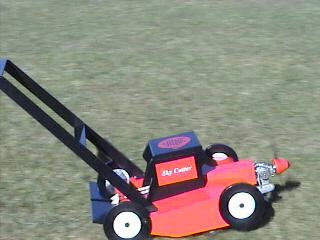
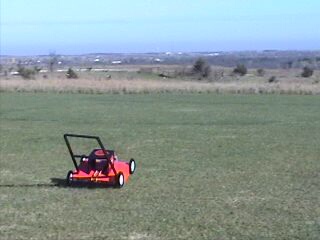
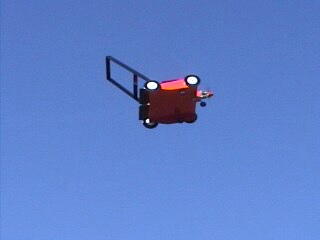

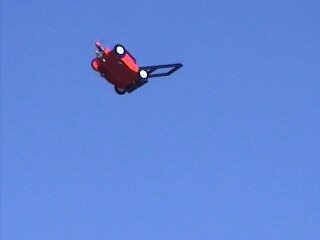
Throttle up.....
Rotate.....
Liftoff.....
Trim out..... Relax!
Start puttin' it to it..... tight turns and loops
